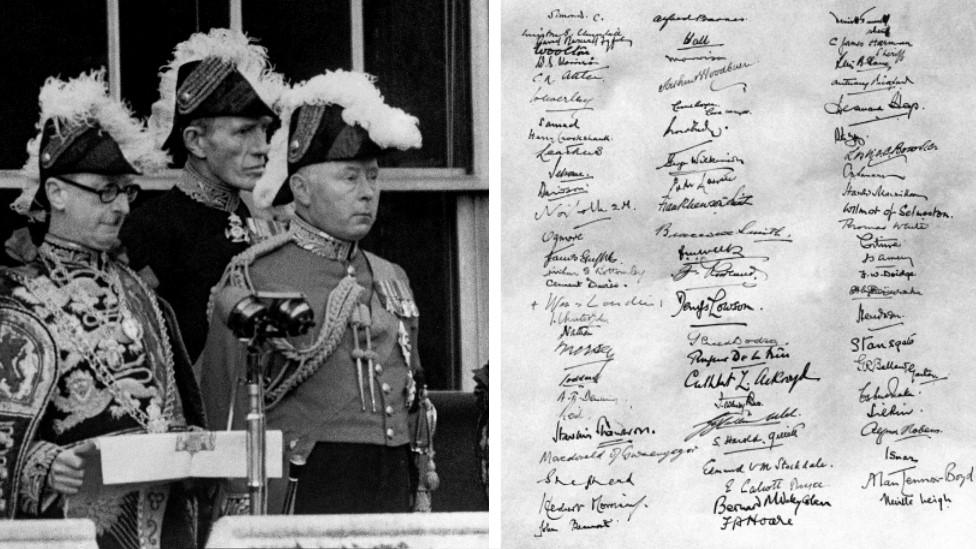King Charles III: A guide to his Accession Council and proclamation
- Published

The reading of the first public proclamation of the accession of Queen Elizabeth II, 1952
The new king has been proclaimed by an Accession Council. What exactly does that mean?
Charles is already king - under the terms of the Act of Settlement 1701, he automatically became so on the death of his mother. So the purpose of the Accession Council is basically a ceremonial one - it officially announces the name of the new monarch.
Normally, this happens within 24 hours of the death of the sovereign. But on this occasion a little more time will have passed between the death of Queen Elizabeth II and the ceremony at St James's Palace in London.
In another break with tradition, King Charles III has decided that for the first time the Accession Council will be televised.
Who attended, and what took place?
The council is attended by members of the Privy Council (a group of senior politicians that formally advise the monarch), the Lord Mayor of the City of London, and senior judges and officials.
The Accession Council is divided into two parts, and Charles will only be present for the second.
In the first part, the Lord President - the MP Penny Mordaunt, appointed by Liz Truss on 6 September - announced the monarch's death.
She then asked the clerk of the council, currently retired civil servant Richard Tilbrook, to read out the Accession Proclamation, which confirms the name of the new monarch.
The proclamation was then signed by the members of the Royal Family, the prime minister, the Archbishop of Canterbury, the Lord Chancellor and the Earl Marshall - the Duke of Norfolk, who is responsible for organising state ceremonies.
After the signing, Ms Mordaunt called for silence then read out the outstanding items of business, which include disseminating the proclamation and directing that artillery guns will be fired at Hyde Park in central London and the Tower of London.
The proclamation was then read out from a balcony above the Friary Court at St James's Palace by the Garter King of Arms, England's senior herald. He was joined by the Earl Marshall and other officials wearing traditional heraldic garments.
The proclamation was also read in Belfast, Cardiff and Edinburgh, and other locations around the country.

The accession of Queen Elizabeth II and the proclamation of her accession in 1952
What is Charles' role?
Part two of the Accession Council was the first meeting of the Privy Council held by the new monarch, and Charles began with a personal declaration.
According to Robert Hazell, professor of government and the constitution at University College London, this usually has three elements. The king commemorates the Queen, affirms his fidelity to the constitution and expresses "hope for the support of the nation in his heavy responsibilities".
Under the terms of the Act of Union, new monarchs are also required to make an oath to maintain and preserve the Church of Scotland. Usually, this takes place at part two of the Accession Council and the new monarch signs two copies of the oath.
Charles can say if he objects to any of the oaths he is asked to make, although the last time a new monarch did so was in 1910 when King George V rejected the anti-Catholic wording of the declaration oath. The government of the time evidently agreed with him as they changed the wording in the Accession Declaration Act 1910.
The Accession Council has now concluded its business, but it may be some time before Charles's coronation takes place. Some 16 months passed between the death of Queen Elizabeth's father, King George VI, in February 1952 and her coronation in June 1953.